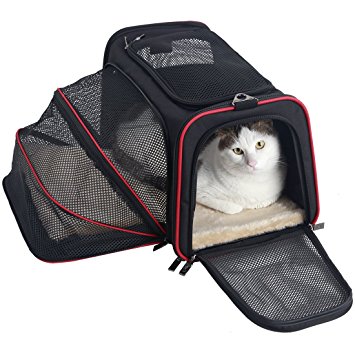Trying to get your cat to do something it doesn?t want to be a bit like, well, herding cats.
In simple terms: impossible. Like many humans, some cats are very nervous flyers.
Cats generally react badly to unfamiliar places, smells and sensations.
Therefore, taking your cat onto an airplane can, therefore, be very difficult. As well as trying to make your pet as comfortable as possible, you have to consider other passengers, who may not be keen on having a loud, thrashing fur ball sitting next to them.

The choice is huge, with different shapes, sizes and designs depending on your pet?s needs and the intended use. If you?re taking your cat on a plane, you?ll need to purchase a carrier which is airline approved.
Pet Carrier Airline Requirements
- The carrier has to be large enough for your pet to stand, turn around and lie down comfortably.
- If your pet is travelling in the hold of the plane, the carrier must be made of fiberglass; metal or rigid plastic and the floor must be solid and leak proof. Hard shell carriers provide sturdy protection for your pet are better at withstanding any knocks, plus they are more likely to contain any liquids if your pet has an accident. Soft carriers are generally acceptable if your pet is travelling in the cabin, plus they have the added advantage of being collapsible so they?re much easier to store.
- Carriers which are going in the cargo of the plane must have a secure, spring loaded, all round locking system with the pins extending at least 1.6cm above and below the door. Doors must be constructed of heavy plastic, welded or cast metal strong enough so that a pet cannot bend them.
- Hold carriers cannot have wheels, or the wheels must be able to be removed/taped so that it cannot roll around the cargo section (imagine that!)
We?ve put together a list of the best cat carriers for both in cabin and hold travel so that your pet is comfortable during its adventure.
